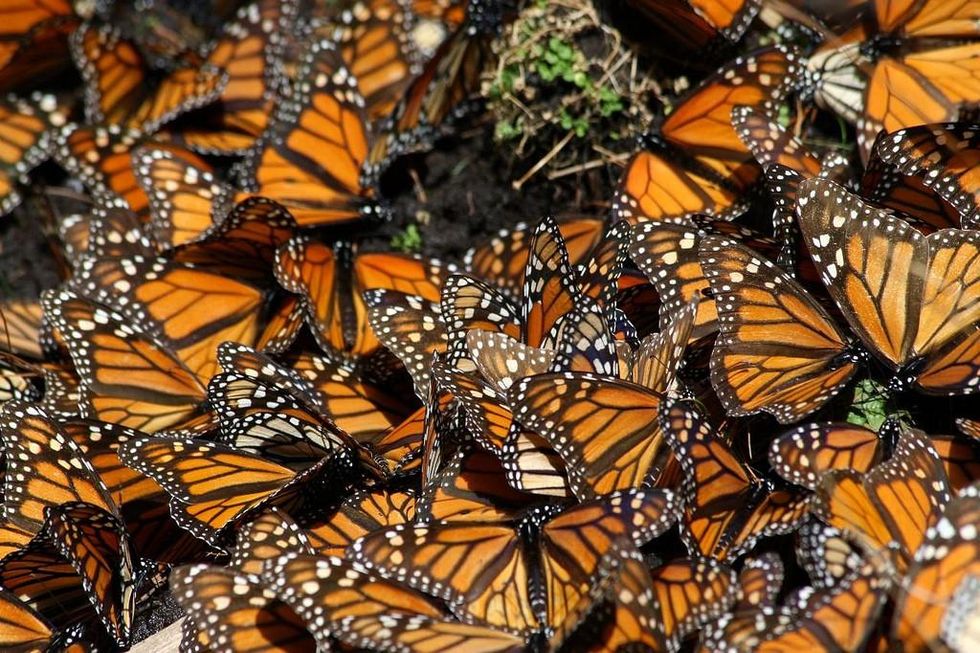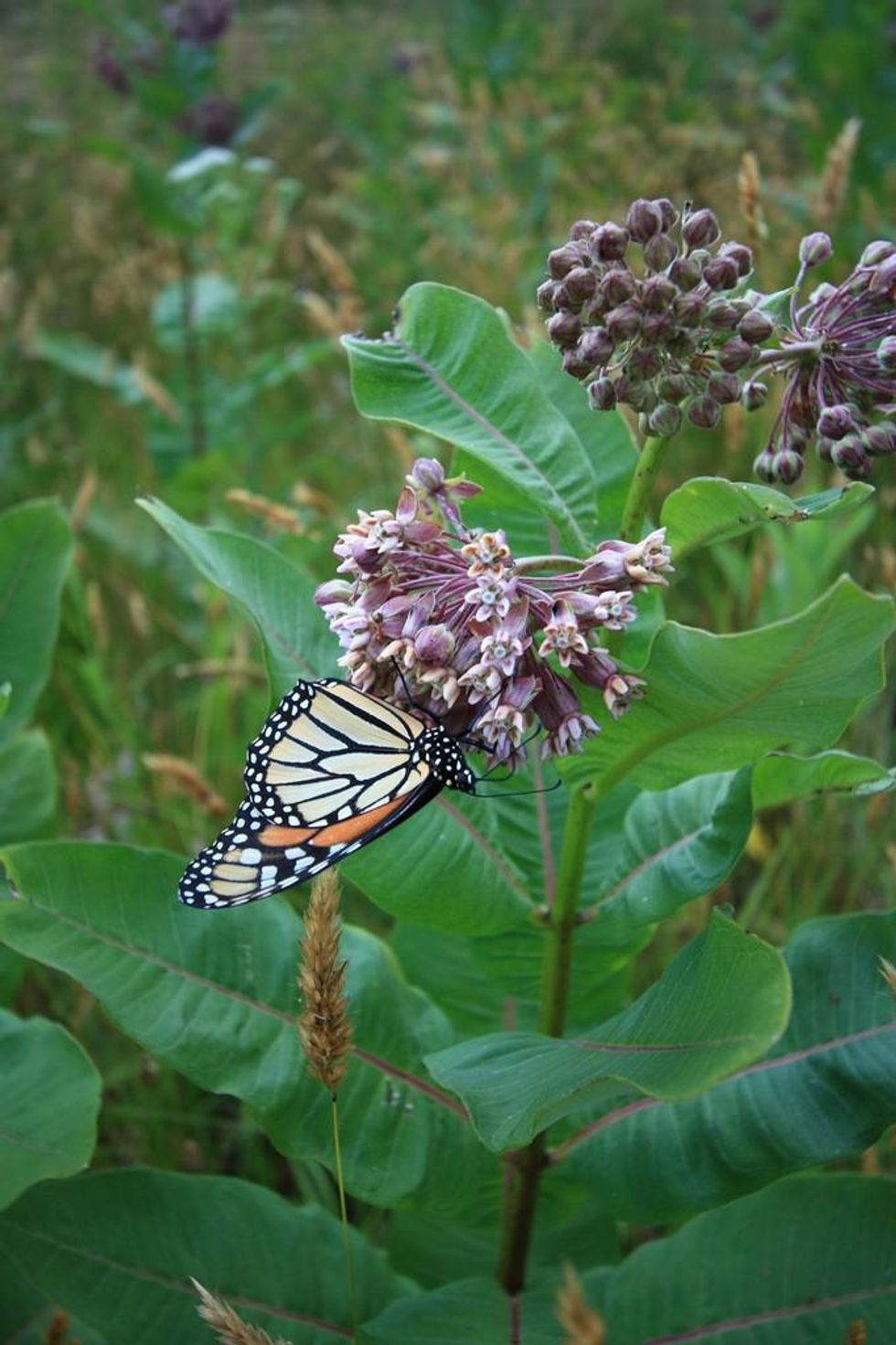

SUBSCRIBE TO OUR FREE NEWSLETTER
Daily news & progressive opinion—funded by the people, not the corporations—delivered straight to your inbox.
5
#000000
#FFFFFF
To donate by check, phone, or other method, see our More Ways to Give page.


Daily news & progressive opinion—funded by the people, not the corporations—delivered straight to your inbox.

A new report from the World Wildlife Fund and Mexico's National Commission for Protected Areas found that the number of monarch butterflies hibernating in Mexico dropped to its lowest level since records began in 1993.
The insects make an epic journey of thousands of miles each year from Canada and the U.S. to spend November through March hibernating in Mexico's temperate forests.
Clues that this year's numbers would be the continuation of a troubling trend have been in for months, with the new study bringing more grim proof that the monarch is in trouble.
Using satellite and aerial photographs, the new study documented that 1.65 acres of forest were inhabited by monarchs during December of 2013, marking a 44% drop from the same time in 2012.
"Twenty years after the signing of NAFTA, the monarch butterfly migration - a symbol of cooperation between our three countries - is in grave danger," stated Omar Vidal, WWF-Mexico Director General.
While the study focused on deforestation and forest degradation in monarch reserves that serve as their winter habitat, it points to a trio of perils contributing to declining numbers of monarchs.

There are 3 primary threats to the monarch butterfly in its range in North America: deforestation and degradation of forest by illegal logging of overwintering sites in Mexico; widespread reduction of breeding habitat in the United States due to land-use changes and the decrease of this butterfly's main larval food plant (common milkweed [Asclepias syriaca]) associated with the use of glyphosate herbicide to kill weeds growing in genetically engineered, herbicide-resistant crops; and periodic extreme weather conditions throughout its range during the year, such as severe cold or cold summer or winter temperatures.
Other butterfly experts have pointed to these three factors as well, though Lincoln Brower, a professor of biology at Sweet Briar College who has studied the monarch migrations for decades, told the Washington Post's Brad Plumer that "The most catastrophic thing from the point of view of the monarch butterfly has been the expansion of crops that are planted on an unbelievably wide scale throughout the Midwest and have been genetically manipulated to be resistant to the powerful herbicide Roundup."
Another leading scientist who has spent three decades studying the monarch, Karen Oberhauser, professor at the University of Minnesota, added to this point, saying "Numerous lines of evidence demonstrate that the Corn Belt in the U.S. Midwest is the primary source for monarchs hibernating in Mexico," and the region has been hit by the explosive use of Roundup-resistant crops.
This has meant that milkweed, the host plant for the monarch caterpillar, is being wiped out from fields, something that Chip Ward, Director of Monarch Watch, has been documenting.
"These genetically modified crops have resulted in the extermination of milkweed from many agricultural habitats," added Oberhauser.
Dr. Phil Schappert, a Canadian butterfly conservationist, added in a statement that "'the economy first' practices, instead of sustainable land use practices, threaten monarch habitat" in Canada, and urges his country and the United States to "implement measures that protect the reproductive habitat and feeding grounds of this butterfly. Otherwise, this spiral of population decline will continue," Schappert added.
Monarch Watch's Ward adds, "Let's plant milkweed - lots and lots of it."
__________________
Dear Common Dreams reader, The U.S. is on a fast track to authoritarianism like nothing I've ever seen. Meanwhile, corporate news outlets are utterly capitulating to Trump, twisting their coverage to avoid drawing his ire while lining up to stuff cash in his pockets. That's why I believe that Common Dreams is doing the best and most consequential reporting that we've ever done. Our small but mighty team is a progressive reporting powerhouse, covering the news every day that the corporate media never will. Our mission has always been simple: To inform. To inspire. And to ignite change for the common good. Now here's the key piece that I want all our readers to understand: None of this would be possible without your financial support. That's not just some fundraising cliche. It's the absolute and literal truth. We don't accept corporate advertising and never will. We don't have a paywall because we don't think people should be blocked from critical news based on their ability to pay. Everything we do is funded by the donations of readers like you. Will you donate now to help power the nonprofit, independent reporting of Common Dreams? Thank you for being a vital member of our community. Together, we can keep independent journalism alive when it’s needed most. - Craig Brown, Co-founder |

A new report from the World Wildlife Fund and Mexico's National Commission for Protected Areas found that the number of monarch butterflies hibernating in Mexico dropped to its lowest level since records began in 1993.
The insects make an epic journey of thousands of miles each year from Canada and the U.S. to spend November through March hibernating in Mexico's temperate forests.
Clues that this year's numbers would be the continuation of a troubling trend have been in for months, with the new study bringing more grim proof that the monarch is in trouble.
Using satellite and aerial photographs, the new study documented that 1.65 acres of forest were inhabited by monarchs during December of 2013, marking a 44% drop from the same time in 2012.
"Twenty years after the signing of NAFTA, the monarch butterfly migration - a symbol of cooperation between our three countries - is in grave danger," stated Omar Vidal, WWF-Mexico Director General.
While the study focused on deforestation and forest degradation in monarch reserves that serve as their winter habitat, it points to a trio of perils contributing to declining numbers of monarchs.

There are 3 primary threats to the monarch butterfly in its range in North America: deforestation and degradation of forest by illegal logging of overwintering sites in Mexico; widespread reduction of breeding habitat in the United States due to land-use changes and the decrease of this butterfly's main larval food plant (common milkweed [Asclepias syriaca]) associated with the use of glyphosate herbicide to kill weeds growing in genetically engineered, herbicide-resistant crops; and periodic extreme weather conditions throughout its range during the year, such as severe cold or cold summer or winter temperatures.
Other butterfly experts have pointed to these three factors as well, though Lincoln Brower, a professor of biology at Sweet Briar College who has studied the monarch migrations for decades, told the Washington Post's Brad Plumer that "The most catastrophic thing from the point of view of the monarch butterfly has been the expansion of crops that are planted on an unbelievably wide scale throughout the Midwest and have been genetically manipulated to be resistant to the powerful herbicide Roundup."
Another leading scientist who has spent three decades studying the monarch, Karen Oberhauser, professor at the University of Minnesota, added to this point, saying "Numerous lines of evidence demonstrate that the Corn Belt in the U.S. Midwest is the primary source for monarchs hibernating in Mexico," and the region has been hit by the explosive use of Roundup-resistant crops.
This has meant that milkweed, the host plant for the monarch caterpillar, is being wiped out from fields, something that Chip Ward, Director of Monarch Watch, has been documenting.
"These genetically modified crops have resulted in the extermination of milkweed from many agricultural habitats," added Oberhauser.
Dr. Phil Schappert, a Canadian butterfly conservationist, added in a statement that "'the economy first' practices, instead of sustainable land use practices, threaten monarch habitat" in Canada, and urges his country and the United States to "implement measures that protect the reproductive habitat and feeding grounds of this butterfly. Otherwise, this spiral of population decline will continue," Schappert added.
Monarch Watch's Ward adds, "Let's plant milkweed - lots and lots of it."
__________________

A new report from the World Wildlife Fund and Mexico's National Commission for Protected Areas found that the number of monarch butterflies hibernating in Mexico dropped to its lowest level since records began in 1993.
The insects make an epic journey of thousands of miles each year from Canada and the U.S. to spend November through March hibernating in Mexico's temperate forests.
Clues that this year's numbers would be the continuation of a troubling trend have been in for months, with the new study bringing more grim proof that the monarch is in trouble.
Using satellite and aerial photographs, the new study documented that 1.65 acres of forest were inhabited by monarchs during December of 2013, marking a 44% drop from the same time in 2012.
"Twenty years after the signing of NAFTA, the monarch butterfly migration - a symbol of cooperation between our three countries - is in grave danger," stated Omar Vidal, WWF-Mexico Director General.
While the study focused on deforestation and forest degradation in monarch reserves that serve as their winter habitat, it points to a trio of perils contributing to declining numbers of monarchs.

There are 3 primary threats to the monarch butterfly in its range in North America: deforestation and degradation of forest by illegal logging of overwintering sites in Mexico; widespread reduction of breeding habitat in the United States due to land-use changes and the decrease of this butterfly's main larval food plant (common milkweed [Asclepias syriaca]) associated with the use of glyphosate herbicide to kill weeds growing in genetically engineered, herbicide-resistant crops; and periodic extreme weather conditions throughout its range during the year, such as severe cold or cold summer or winter temperatures.
Other butterfly experts have pointed to these three factors as well, though Lincoln Brower, a professor of biology at Sweet Briar College who has studied the monarch migrations for decades, told the Washington Post's Brad Plumer that "The most catastrophic thing from the point of view of the monarch butterfly has been the expansion of crops that are planted on an unbelievably wide scale throughout the Midwest and have been genetically manipulated to be resistant to the powerful herbicide Roundup."
Another leading scientist who has spent three decades studying the monarch, Karen Oberhauser, professor at the University of Minnesota, added to this point, saying "Numerous lines of evidence demonstrate that the Corn Belt in the U.S. Midwest is the primary source for monarchs hibernating in Mexico," and the region has been hit by the explosive use of Roundup-resistant crops.
This has meant that milkweed, the host plant for the monarch caterpillar, is being wiped out from fields, something that Chip Ward, Director of Monarch Watch, has been documenting.
"These genetically modified crops have resulted in the extermination of milkweed from many agricultural habitats," added Oberhauser.
Dr. Phil Schappert, a Canadian butterfly conservationist, added in a statement that "'the economy first' practices, instead of sustainable land use practices, threaten monarch habitat" in Canada, and urges his country and the United States to "implement measures that protect the reproductive habitat and feeding grounds of this butterfly. Otherwise, this spiral of population decline will continue," Schappert added.
Monarch Watch's Ward adds, "Let's plant milkweed - lots and lots of it."
__________________